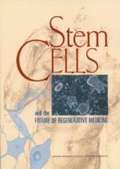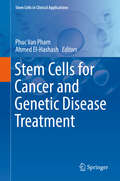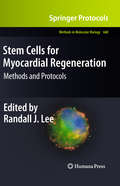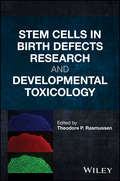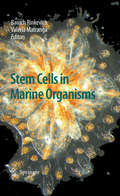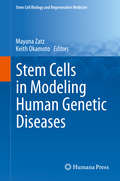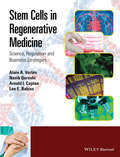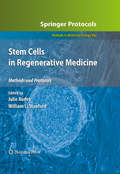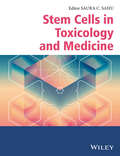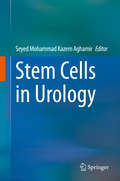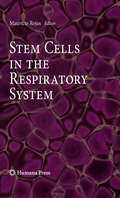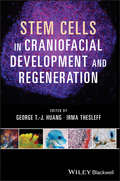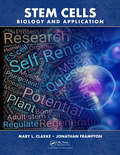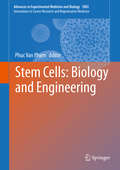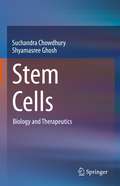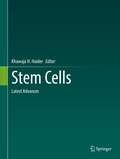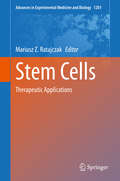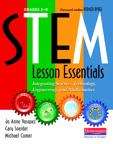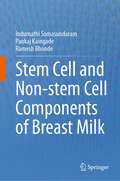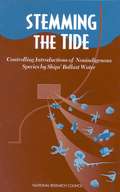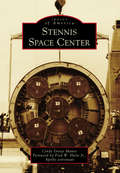- Table View
- List View
Stem Cells and Tissue Repair: Methods and Protocols (Methods in Molecular Biology #2155)
by Chrissa KioussiThis volume looks at a collection of stem cell and regenerative techniques used by both novice and expert scientists. Chapters cover topics such as tissue repaired by expansion and reprogramming; induced pluripotent stem cells driven in neuronal or vascular differentiation; using mesenchymal stem cells to derive skeletal muscle, osteoblasts, and spermatogonial cells; and the technique of monitoring the development of sub-organ microenvironments in the developing pancreas. Written in the highly successful Methods in Molecular Biology series format, chapters include introductions to their respective topics, lists of the necessary materials and reagents, step-by-step, readily reproducible laboratory protocols, and tips on troubleshooting and avoiding known pitfalls.Cutting-edge and thorough, Stem Cells and Tissue Repair: Methods and Protocols, Second Edition is a valuable resource that provides readers with the latest descriptions and references for exploring this vast field in regenerative medicine.
Stem Cells and the Future of Regenerative Medicine
by National Research CouncilRecent scientific breakthroughs, celebrity patient advocates, and conflicting religious beliefs have come together to bring the state of stem cell research—specifically embryonic stem cell research—into the political crosshairs. President Bush’s watershed policy statement allows federal funding for embryonic stem cell research but only on a limited number of stem cell lines. Millions of Americans could be affected by the continuing political debate among policymakers and the public. Stem Cells and the Future of Regenerative Medicine provides a deeper exploration of the biological, ethical, and funding questions prompted by the therapeutic potential of undifferentiated human cells. In terms accessible to lay readers, the book summarizes what we know about adult and embryonic stem cells and discusses how to go about the transition from mouse studies to research that has therapeutic implications for people. Perhaps most important, Stem Cells and the Future of Regenerative Medicine also provides an overview of the moral and ethical problems that arise from the use of embryonic stem cells. This timely book compares the impact of public and private research funding and discusses approaches to appropriate research oversight. Based on the insights of leading scientists, ethicists, and other authorities, the book offers authoritative recommendations regarding the use of existing stem cell lines versus new lines in research, the important role of the federal government in this field of research, and other fundamental issues.
Stem Cells for Cancer and Genetic Disease Treatment (Stem Cells in Clinical Applications)
by Phuc Van Pham Ahmed El-HashashThis invaluable resource discusses insights ranging from basic biological mechanisms of various types of stem cells through the potential applications in the treatment of human diseases, including cancer and genetic disorders. These discoveries are placed within the structural context of tissue and developmental biology in sections dealing with recent advances in understanding different types of stem cell biology and their potential applications in tissue repair and regeneration and in the treatment different types of human cancer and genetic diseases or disorders.Stem Cells for Cancer and Genetic Disease Treatment and the other books in the Stem Cells in Clinical Applicationsseries will be invaluable to scientists, researchers, advanced students and clinicians working in stem cells, regenerative medicine or tissue engineering as well as cancer or genetics research.
Stem Cells for Myocardial Regeneration
by Randall J. LeeThere is currently a great deal of enthusiasm surrounding organ regeneration, which mainly comes from the potential pleuripotency of stem cells to differentiate into various tissue types. In Stem Cells for Myocardial Regeneration: Methods and Protocols, expert researchers explore exciting new developments in the field of regenerative medicine, focusing both on the benefits of using stem cells in myocardial repair and regeneration and on the challenges associated with making this a mainstream therapy. Chapters consider the optimal cell type for myocardial repair, examine the developmental processes of the human heart in order to develop strategies for regeneration, consider ex-vivo optical mapping and in vivo electrophysiology studies, and investigate the effects of the extracellular matrix on stem cell renewal and differentiation. Composed in the highly successful Methods in Molecular Biology(tm) series format, each chapter contains a brief introduction, step-by-step methods, a list of necessary materials, and a Notes section which shares tips on troubleshooting and avoiding known pitfalls. Ground-breaking and current, Stem Cells for Myocardial Regeneration: Methods and Protocols, is an essential guide for scientists, translational investigators, and cardiologists alike, providing readers with a means to evaluate the efficacy and safety of adopting stem cells as the standard for myocardial regeneration.
Stem Cells in Birth Defects Research and Developmental Toxicology
by Theodore P. RasmussenThis book contains material contributed by forward-looking scientists who work at the interface of stem cell research and applied science with the aim to improve human fetal safety and the understanding of human developmental and degenerative disorders. Provides important platforms and contemporary accounts of the state of stem cell research in the fields of toxicology and teratology Considers both in vitro uses of stem cells as platforms for teratology and also stem cellopathies, which are in vivo developmental and degenerative disorders Helps the pharmaceutical industry and safety and environmental authorities validate the status quo of in vitro toxicity test systems based on human pluripotent stem cells and their derivatives
Stem Cells in Marine Organisms
by Valeria Matranga Baruch RinkevichDo real stem cells and stem cell lineages exist in lower organisms? Can stem cells from one organism parasitize the soma and/or the germ line of conspecifics? Can differentiated cells in marine organisms be re-programmed to regenerate tissues, organs and appendages through novel de-differentiation, transdifferentiation, or re-differentiation processes, leading to virtually all three germ layers, including the germline? The positive answers to above questions open a new avenue in stem cell research: the biology of stem cells in marine organisms. It is therefore unfortunate that while the literature on stem cell from terrestrial organisms is rich and expanding at an exponential rate, investigations on marine organisms' stem cells are very limited and scarce. By presenting theoretical chapters, overview essays and specific research results, this book summarises the knowledge and the hypotheses on stem cells in marine organisms through major phyla and specific model organisms. The study on stem cells from marine invertebrates may shed lights on mechanisms promoting immunity, developmental biology, regeneration and budding processes in marine invertebrates, body maintenance, aging and senescence. It aims in encouraging a larger scientific community to follow and study the novel phenomena of stem cells behaviours as depicted from the few currently studied marine invertebrates.
Stem Cells in Modeling Human Genetic Diseases
by Mayana Zatz Oswaldo Keith OkamotoWhile most stem cell books focus on basic aspects and/or cell therapy, this book emphasizes the relevance of stem cells obtained from patients, the so-called "patients in a petri dish" as tools to investigate human genetic diseases for which there are no available effective treatment. Chapters embrace several examples of the use of iPS cell technology, a recent Nobel Prize-winning scientific breakthrough, to obtain patient-specific pluripotent cells from which many types of specialized cells involved in a particular disease can be generated, including psychiatric and neurodegenerative disorders, muscular dystrophies, laminopathies, among others. The text is a current and timely resource for postgraduate students, scientists and clinicians, interested in applications of this rapidly developing field of research in disease modeling, drug development, and emerging issues that it brings to regenerative medicine.
Stem Cells in Regenerative Medicine
by Nasib Qureshi Lee E. Babiss Arnold I. Caplan Alain A. VertesThis book is a unique guide to emerging stem cell technologies and the opportunities for their commercialisation. It provides in-depth analyses of the science, business, legal, and financing fundamentals of stem cell technologies, offering a holistic assessment of this emerging and dynamic segment of the field of regenerative medicine.* Reviews the very latest advances in the technology and business of stem cells used for therapy, research, and diagnostics* Identifies key challenges to the commercialisation of stem cell technology and avenues to overcome problems in the pipeline* Written by an expert team with extensive experience in the business, basic and applied science of stem cell researchThis comprehensive volume is essential reading for researchers in cell biology, biotechnology, regenerative medicine, and tissue engineering, including scientists and professionals, looking to enter commercial biotechnology fields.logy and avenues to overcome problems in the pipelineWritten by an expert team with extensive experience in the business, basic and applied science of stem cell researchThis comprehensive volume is essential reading for researchers in cell biology, biotechnology, regenerative medicine, and tissue engineering, including scientists and professionals, looking to enter commercial biotechnology fields. It is valuable for R&D staff in academia, biotechnology and pharmaceutical companies,and professionals from consulting firms, regulatory agencies, and patenting offices, also to business and scientific managers, venture capitalists, business development professionals, corporate strategists, policy makers, patient advocates, and healthcare payers. It also constitutes a useful resource as a textbook to support science andbusiness students looking into courses in the field of regenerative medicine.
Stem Cells in Regenerative Medicine
by William L. Stanford Julie AudetAs regenerative medicine involves replacing diseased cells, tissues or organs, or repairing tissues in vivo, the manipulation of stem cells underlie its goals. In Stem Cells in Regenerative Medicine: Methods and Protocols, leading experts in the field provide an updated representation of the landscape of stem cell-based therapies in a wide spectrum of tissue systems and ontogenic stages, from the isolation and culture of stem cells to their actual use in vivo. Written in the highly successful Methods in Molecular BiologyTM series format, these chapters include brief introductions to the topic, lists of the necessary materials and reagents, readily reproducible, step-by-step laboratory protocols, and tips for troubleshooting and avoiding known pitfalls. Comprehensive and easy-to-use, Stem Cells in Regenerative Medicine: Methods and Protocols is certain to contribute greatly to the definition of standardized procedures for the manipulation of somatic and embryonic stem cells in research and clinical applications.
Stem Cells in Reproductive Tissues and Organs: From Fertility to Cancer (Stem Cell Biology and Regenerative Medicine #70)
by Irma Virant-KlunThis contributed volume gathers the latest knowledge in the field of stem cells in human reproductive organs, as well as animal models, and to consider the possibility of using this knowledge for clinical purposes. The scope of the book covers both clinical and basic knowledge of stem cells in both reproductive medicine (gynecology and obstetrics) and regenerative medicine as well as cellular and molecular medicine and reproductive biology. Chapters on basic stem cell knowledge in human reproductive tissues and organs or animal models are included, as well as clinical knowledge on their role in the manifestation of infertility and cancer and their clinical use.
Stem Cells in Toxicology and Medicine
by Saura C. SahuA comprehensive and authoritative compilation of up-to-date developments in stem cell research and its use in toxicology and medicine Presented by internationally recognized investigators in this exciting field of scientific research Provides an insight into the current trends and future directions of research in this rapidly developing new field A valuable and excellent source of authoritative and up-to-date information for researchers, toxicologists, drug industry, risk assessors and regulators in academia, industry and government
Stem Cells in Urology
by Seyed Mohammad Kazem AghamirThis contributed volume emphasizes the potential of stem cells to be pertained in the urology field and attempts to disclose the history of the field up to the latest advances to date. It gathers the majority of papers that advocate utilizing stem cells as the best option for treating, diagnosing, and managing diseases related to urological system. This book covers a broad spectrum of issues, including mesenchymal stem cells, cancer stem cells, organoids, regenerative medicine, erectile dysfunction, bladder dysfunction, and kidney transplant. From several decades ago, as characteristic features of stem cells have been explored, it has attracted a great amount of interests. In view of their multiple capacity of differentiating into various lineages, many studies were conducted to assess their beneficial potential. Despite considerable progress into applying stem cells in animal models, for translating into clinical practices there are several obstacles to be resolved. However, few clinical studies have been performed in each field and outcomes were delightful. There is an ongoing hope for stem cells to someday, be the mainstream treatments of urological diseases, although stem cells treatments already exist they are not well-known. Indeed, this book is essential for anyone who is working with the purpose of employing stem cells to treat the urological diseases and discusses at length the latest advances as well as their limitations.
Stem Cells in Veterinary Science
by Ratan Kumar Choudhary Shanti ChoudharyThis book explores the potential applications of animal stem cells in veterinary medicine. It begins with an overview of stem cells and their application in treating various animal diseases, including mastitis. In turn, the book discusses the challenges of using stem cells in regenerative medicine and emphasizes the importance of understanding the action of stem cells and preclinical evidence for ensuring safety and therapeutic efficacy. It also presents methods for the identification, characterization, and quantification of stem cells. Further, it discusses the therapeutic applications of different stem cells, including milk-derived, testicular, and mesenchymal stem cells in veterinary medicine. Lastly, it discusses strategies for and therapeutic applications of genome editing by CRISPER/Cas9 in mammary stem cells. As such, the book offers a valuable resource for students and scientists working in the veterinary sciences and veterinarians.
Stem Cells in the Respiratory System
by Mauricio RojasIn this state-of-the-art exploration of a hugely dynamic and fast-evolving field of research, leading researchers share their collective wisdom on the role that stem cells could play in the context of physiological stress and lung injury. The text focuses on reviewing the most relevant--and recent--ideas on using local, endogenous, and exogenous progenitor/stem cells in preventing and treating injury to the lung. The lungs are one of the most complex organs in the human body, with a mature adult lung boasting at least 40 morphologically differentiated cell lineages. Our entire blood supply passes through the lung's alveolar units during oxygenation. This interaction with the outside world, along with the intricacies of its structure, makes the lung a highly susceptible organ that is vulnerable to numerous types of injury and infection. This means that the mechanisms of lung repair are in themselves correspondingly complex. Because of their multipotentiality, as well as the fact of the lung's relatively rapid cell turnover, stem cells are thought to be an important alternative cell-base therapy in lung injury. Despite the controversial nature of stem cell research, there has been growing interest in both local and endogenous stem cells in the lung. This highly topical book with chapters on everything from using mesenchymal stem cells in lung repair to the effect of physical activity on the mobilization of stem and progenitor cells, represents an exciting body of work by outstanding investigators and will be required reading for those with an interest in the subject.
Stem Cells, Craniofacial Development and Regeneration
by Irma Thesleff George T.J. HuangStem Cells, Craniofacial Development and Regeneration is an introduction to stem cells with an emphasis on their role in craniofacial development. Divided into five sections, chapters build from basic introductory information on the definition and characteristics of stem cells to more indepth explorations of their role in craniofacial development. Section I covers embryonic and adult stem cells with a focus on the craniofacial region, while sections II-IV cover the development and regeneration of craniofacial bone, tooth, temporomandibular joint, salivary glands and muscle. Concluding chapters describe the current, cutting-edge research utilizing stem cells for craniofacial tissue bioengineering to treat lost or damaged tissue.The authoritative resource for dentistry students as well as craniofacial researchers at the graduate and post-graduate level, Stem Cells, Craniofacial Development and Regeneration explores the rapidly expanding field of stem cells and regeneration from the perspective of the dentistry and craniofacial community, and points the way forward in areas of tissue bioengineering and craniofacial stem cell therapies.
Stem Cells: Biology and Application
by Mary Clarke Jonathan FramptonStem cell science, encompassing basic biology to practical application, is both vast and diverse. A full appreciation of it requires an understanding of cell and molecular biology, tissue structure and physiology, the practicalities of tissue engineering and bioprocessing, and the pathways to clinical implementation—including the ethical and regulatory imperatives that our society requires us to address. Expectation and debate have been driven by the allure of regenerative medicine using stem cells as a source of replacements for damaged or aged tissues. The potential of stem cell application goes far beyond this. Highly innovative uses of stem cells are emerging as possible therapies for cancers, treating acute damage in conditions such as stroke and myocardial infarction, and resolving a whole range of diseases. Stem Cells: Biology and Application presents the basic concepts underlying the fast-moving science of stem cell biology. This textbook is written for an advanced stem cell biology course. The target audience includes senior undergraduates, first year graduate students, and practitioners in molecular biology, biology, and biomedical engineering. Stem Cells provides a comprehensive understanding of these unique cells, highlighting key areas of research, associated controversies, case studies, technologies, and pioneers in the field.
Stem Cells: Biology and Engineering (Advances in Experimental Medicine and Biology #1083)
by Phuc Van PhamThis new series, based on a bi-annual conference and its topics, represents a major contribution to the emerging science of cancer research and regenerative medicine. Each volume brings together some of the most pre-eminent scientists working on cancer biology, cancer treatment, cancer diagnosis, cancer prevention and regenerative medicine to share information on currently ongoing work which will help shape future therapies. These volumes are invaluable resources not only for already active researchers or clinicians but also for those entering these fields, plus those in industry. Stem Cells: Biology and Engineering is a proceedings volume which reflects papers presented at the Innovations in Regenerative Medicine and Cancer Research conference; taken with its companion volume Tissue Engineering and Regenerative Medicine it provides a complete overview of the papers from that meeting of international experts.
Stem Cells: Biology and Therapeutics
by Shyamasree Ghosh Suchandra ChowdhuryStem cells hold great promise for cell therapy, tissue engineering, regenerative medicine and pharmaceutical and biotechnological applications. This book highlights the potency of stem cells, their property of self-renewal and their ability to differentiate into different cell lineages. It further describes the different markers to identify stem cells, sources, methods of isolation, culture including 2D, 3D and beyond and their cryopreservation. This is among the first books to discuss glycosylation and sialylation in stem cells. Chapters describe application of stem cells in regenerative medicine and therapy, and highlight their application in cancer therapy and spinal cord injury. The book talks about the important patents on stem cells. The book also highlights the plant stem cells, discussing their pluoripotent nature, role in organ regeneration after injury, specific stem cell niches, that signals to block differentiation studied in plants shoot, root, and vascular meristems, differentiation of plant stem cell, transcriptional regulation and epigenetic modification of plant stem cells. This book is exciting and cutting edge. It will be of great interest to doctors, students and researchers in the field of regenerative medicine, cancer , biotechnology and plant sciences.
Stem Cells: Latest Advances
by Khawaja H. HaiderIn this volume, the contributing authors from top labs involved in stem cell theranostics share the latest advances in the field of stem cell research. The book covers many aspects of stem cell-based therapy and the progress made toward stem cell therapy for liver, ocular, and cardiovascular diseases as well as cancer. This volume serves as a continuation of Prof. Khawaja Husnain Haider’s previously edited books pertaining to stem cells-based therapnostics. This is an ideal book for researchers involved in drug development as well as regenerative medicine and stem cell-based therapy. The secondary audience includes graduate and postgraduate medical students, doctors, cellular pharmacology, drug industry, and researchers involved in using stem cells as ex-vivo disease models for drug development.
Stem Cells: Therapeutic Applications (Advances in Experimental Medicine and Biology #1201)
by Mariusz Z. RatajczakSince different types of stem cells for therapeutic applications have recently been proposed, this timely volume explores various sources of stem cells for tissue and organ regeneration and discusses their advantages and limitations. Also discussed are pros and cons for using embryonic stem cells, induced pluripotent stem cells, and adult stem cells isolated from postnatal tissues. Different types of adult stem cells for therapeutic applications are also reviewed, including hematopoietic stem cells, epidermal stem cells, endothelial progenitors, neural stem cells, mesenchymal stem cells, and very small embryonic-like stem cells. This book also addresses paracrine effects of stem cells in regenerative medicine that are mediated by extracellular microvesicles and soluble secretome. Finally, potential applications of stem cells in cardiology, gastroenterology, neurology, immunotherapy, and aging are presented. This is an ideal book for students and researchers working in the stem cell research field.
Stem Lesson Essentials, Grades 3-8: Integrating Science, Technology, Engineering, And Mathematics
by Jo Anne Vasquez Michael Comer Cary SneiderIntegrating Science, Technology, Engineering, and Mathematics STEM Lesson Essentials moves beyond the rhetoric and provides knowledge, tools, models, and examples that make STEM a reality of teaching and learning in classrooms. -Rodger Bybee, Executive Director (Retired), Biological Sciences Curriculum Study Want to know how to implement authentic STEM teaching and learning into your classroom? STEM Lesson Essentials provides all the tools and strategies you'll need to design integrated, interdisciplinary STEM lessons and units that are relevant and exciting to your students. With clear definitions of both STEM and STEM literacy, the authors argue that STEM in itself is not a curriculum, but rather a way of organizing and delivering instruction by weaving the four disciplines together in intentional ways. Rather than adding two new subjects to the curriculum, the engineering and technology practices can instead be blended into existing math and science lessons in ways that engage students and help them master 21st century skills. STEM Lesson Essentials shows teachers how to begin the STEM integration journey with: five guiding principles for effective STEM instruction classroom examples of what these principles look like in action sample activities that put all four STEM fields into practice lesson planning templates for STEM units. Explicit connections are made among the STEM practices, including the Common Core Standards for Mathematical Practice and the Framework for K-12 Science Education, helping you easily recognize ways in which STEM lessons can engage students in multiple standards at the same time. With ideas that are practical and achievable in any classroom, STEM Lesson Essentials will give you the confidence and knowledge to weave engineering and technology concepts into your math and science curriculum. STEM teaching doesn't have to be hard. You just have to get started. Try it out with STEM Lesson Essentials, and watch student understanding, achievement, and motivation soar.
Stem cell and Non-stem Cell Components of Breast Milk
by Indumathi Somasundaram Pankaj Kaingade Ramesh BhondeThis book reviews the cellular and non-cellular components of human breast milk and their contribution to infant growth and development. It also discusses various cellular growth factors in breast milk, including stem cells and their significance in promoting optimal growth, immunity and regeneration in neonates and in mitigating several neonatal diseases. Further, the book examines variations in the macronutrient concentrations of human milk in different lactation stages and maternal factors. It also describes the potential of antimicrobial proteins/peptides in human milk to provide innate immunity to infants. Lastly, it explores the regenerative therapeutic applications of breast milk cells in feeding infants.
Stem cells: From Potential to Promise
by Khawaja Husnain HaiderThe book highlights the therapeutic applications of various stem cells, and introduces readers to thymus stem cells and their applications in the reconstitution of thymic structure and function. It also discusses the significant role of mesenchymal stem cells (MSCs) in the treatment of autoimmune diseases and the use of MSC-derived exosomes in cell-free therapy. Moreover, it explores the application of hematopoietic stem cells in the vasculoprotection of the ischemially injured heart. Further topics include the regenerative potential of ovarian germline stem cells and the significance of endometrial stem cells in the pathogenesis of female reproductive tract diseases. Lastly, the book addresses stem cells from perinatal tissues and their immunoregulatory and differentiation potentials, and summarizes new strategies for targeting cancer stem cells to treat tumors.
Stemming the Tide: Controlling Introductions of Nonindigenous Species by Ships' Ballast Water
by Committee on Ships' Ballast OperationsThe European zebra mussel in the Great Lakes, a toxic Japanese dinoflagellate transferred to Australia--such biologically and economically harmful stowaways have made it imperative to achieve better management of ballast water in ocean-going vessels.Stemming the Tide examines the introduction of nonindigenous species through ballast water discharge. Ballast is any solid or liquid that is taken aboard ship to achieve more controlled and safer operation. This expert volume Assesses current national and international approaches to the problem and makes recommendations for U.S. government agencies, the U.S. maritime industry, and the member states of the International Maritime Organization. Appraises technologies for controlling the transfer of organisms--biocides, filtration, heat treatment, and others --with a view toward developing the most promising methods for shipboard demonstration. Evaluates methods for monitoring the effectiveness of ballast water management in removing unwanted organisms. The book addresses the constraints inherent in ballast water management, notably shipboard ballast treatment and monitoring. Also, the committee outlines efforts to set an acceptable level of risk for species introduction using the techniques of risk analysis. Stemming the Tide will be important to all stakeholders in the issue of unwanted species introduction through ballast discharge: policymakers, port authorities, shippers, ship operators, suppliers to the maritime industry, marine biologists, marine engineers, and environmentalists.

